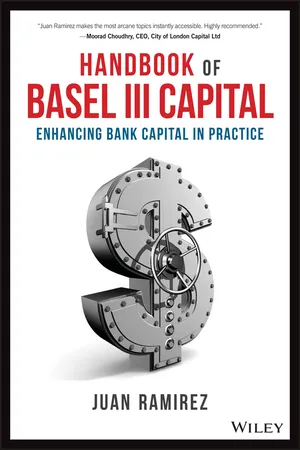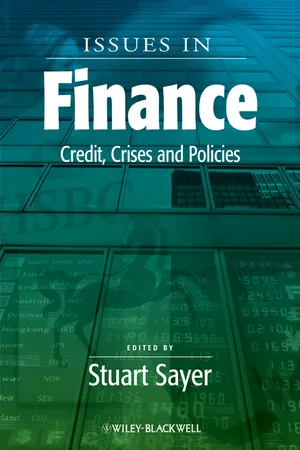Economics
Capital Requirements
Capital requirements refer to the minimum amount of capital that financial institutions, such as banks, are required to hold to ensure their stability and ability to cover potential losses. These requirements are set by regulatory authorities to safeguard the financial system and protect depositors and investors. Meeting capital requirements is essential for banks to maintain solvency and manage risk.
Written by Perlego with AI-assistance
Related key terms
4 Key excerpts on "Capital Requirements"
- eBook - ePub
An Introduction to Banking
Liquidity Risk and Asset-Liability Management
- Moorad Choudhry(Author)
- 2011(Publication Date)
- Wiley(Publisher)
Typically, an institution is subject to the regulatory requirements of its domestic regulator, but it may also be subject to cross-border requirements such as the European Union’s capital adequacy directive. 1 A Capital Requirements scheme proposed by a committee of central banks acting under the auspices of the Bank for International Settlements (BIS) in 1988 has been adopted universally by banks around the world. These are known as the BIS regulatory requirements or the Basel capital ratios, from the town in Switzerland where the BIS is based. 2 Under the Basel requirements all cash and off-balance-sheet instruments in a bank’s portfolio are assigned a risk weighting, based on their perceived credit risk, which determines the minimum level of capital that must be set against them. A bank’s capital is, in its simplest form, the difference between the assets and liabilities on its balance sheet, and is the property of the bank’s owners. It may be used to meet any operating losses incurred by the bank, and if such losses exceed the amount of available capital then the bank will have difficulty in repaying liabilities, which may lead to bankruptcy. However, for regulatory purposes capital is defined differently; again, in its simplest form regulatory capital is comprised of those elements in a bank’s balance sheet that are eligible for inclusion in the calculation of capital ratios. The ratio required by a regulator will be that level deemed sufficient to protect the bank’s depositors. Regulatory capital includes equity, preference shares and subordinated debt, as well as general reserves. The common element of these items is that they are all loss absorbing, whether this is on an ongoing basis or in the event of liquidation - eBook - ePub
Handbook of Basel III Capital
Enhancing Bank Capital in Practice
- Juan Ramirez(Author)
- 2016(Publication Date)
- Wiley(Publisher)
Chapter 2 Minimum Capital RequirementsAny financial institution subject to Basel III regulations is required to hold certain types and amounts of capital to help it meet its obligations as they fall due. This chapter addresses the minimum Capital Requirements for banks. It is important to note that minimum Capital Requirements are not uniform across all banks: they depend on several factors including the jurisdiction where the bank operates and its presence in the domestic and global financial marketplace.2.1 COMPONENTS AND MINIMUM REQUIREMENTS OF BANK CAPITAL
Both Pillar 1 and Pillar 2 result in Capital Requirements for the bank. Pillar 1 sets out the capital needed to absorb unexpected losses or asset impairments stemming from credit risk, counterparty credit risk, market risk and operational risk. Pillar 2 covers the consideration of whether additional capital is required over and above the Pillar 1 Capital Requirements.2.1.1 Pillar 1 Capital Requirements
According to Basel III, a bank's regulatory capital is divided into several categories or tiers of capital, which try to group constituents of capital depending on their degree of permanence and loss absorbency, as shown in Figure 2.1 .Components of a bank's regulatory total capitalFIGURE 2.1Tier 1 capital is so called because it is the best‐quality capital from the regulator's perspective. The objective of Tier 1 capital is to absorb losses and help banks to remain “going concerns” (i.e., to remain solvent, or in other words, to prevent failures). There are two layers of Tier 1 capital:- Common Equity Tier 1 capital (“CET1”), which includes permanent shareholders' equity; and
- Additional Tier 1 capital (“AT1”), which includes some instruments with ability to absorb losses.
Tier 2 capital, a supplementary capital with less loss absorption capabilities, is aimed at providing loss absorption on a “gone concern - eBook - ePub
Financial Stability and Central Banks
A Global Perspective
- Richard Brearley, Juliette Healey, Peter J N Sinclair, Charles Goodhart, David T. Llewellyn, Chang Shu(Authors)
- 2001(Publication Date)
- Routledge(Publisher)
19 It also has the advantage that it is patient capital that cannot easily be redeemed by the holders in the event of a banking crisis. Not surprisingly, therefore, bank regulation has focused heavily on Capital Requirements.Capital Requirements also have an important potential disadvantage, for a binding capital constraint may cause the bank to reduce its lending and so lead to the credit crunch that regulation was designed to avoid.20 Indeed, it has been suggested that the scramble by US banks to meet the standards of the 1988 Basel Accord led to the US credit crunch of the early 1990s.21 Some more reassuring evidence is provided by Ediz, Michael and Perraudin (1998), who found that, as UK banks approached the capital constraint, they boosted their capital ratios principally by increasing Tier 1 capital, though they also shifted their assets to those with lower risk weightings.5.3.2 Are capital constraints binding?
Capital Requirements would serve little purpose if banks wished to hold more than the required level of capital. It does appear that, in the absence of any government safety net or deposit insurance, banks have an incentive to demonstrate to depositors that they have a sufficient equity buffer. Thus, in 1840 before government regulation, US banks voluntarily held equity in excess of 50 per cent of assets. As depositors increasingly acquired protection against bank failure, this ratio declined to about 10 per cent,22 which is significantly less than the amount of equity maintained by finance companies, which do not enjoy implicit or explicit government guarantees.Capital Requirements seem to have contributed to stemming this decline in bank equity. For example, the average risk-weighted capital ratio of G-10 banks rose from 9.3 per cent before the 1988 Basel Accord to 11.2 per cent in 1996. Moreover, the greatest rises were experienced by those countries whose banks were close to, or below, the Basel minimum standards.23 - eBook - ePub
Issues in Finance
Credit, Crises and Policies
- Stuart Sayer(Author)
- 2011(Publication Date)
- Wiley-Blackwell(Publisher)
1 BANK Capital Requirements, BUSINESS CYCLE FLUCTUATIONS AND THE BASEL ACCORDS: A SYNTHESIS Ines Drumond 1. IntroductionThe Basel Committee on Banking Supervision (BCBS) released, in 2004, the new Basel Capital Accord (usually referred to as Basel II) to address some of the major shortcomings of the previous Basel Accord of 1988 (Basel I), thus fostering stability in the financial system. One of the central changes proposed by Basel II is the increased sensitivity of a bank's capital requirement to the risk of its assets: the amount of capital that a bank has to hold is to be directly connected to the riskiness of its underlying assets. This aspect of the new regulation has raised some concerns, at both academic and policy-making levels, because it may accentuate the procyclical tendencies of banking, in the presence of an imperfect market for bank capital: if, during a recession, bank borrowers are downgraded by the credit risk models in use, minimum bank Capital Requirements will increase. To the extent that it is difficult or costly for banks to raise external capital in bad times, this co-movement in bank Capital Requirements and the business cycle may induce banks to further reduce lending during recessions, thereby amplifying the initial downturn.Banking regulation and, in particular, the procyclical effects of Basel II have gained special interest with the current financial crisis that began in 2007 in the US subprime market, then spreading to broader credit and funding markets. As pointed out by Rosengren (2008), banks play a critical role during periods of financial crisis because they are highly leveraged and regulated institutions, and to maintain their capital ratios after experiencing a large negative capital shock they must significantly shrink assets, which, in turn, tends to amplify the effects of economic shocks. Thus, the growing acceptance among investors that banks need to recapitalize led the crisis to deepen further and rendered it more difficult for policy makers to maintain macroeconomic stability.
Learn about this page
Index pages curate the most relevant extracts from our library of academic textbooks. They’ve been created using an in-house natural language model (NLM), each adding context and meaning to key research topics.



